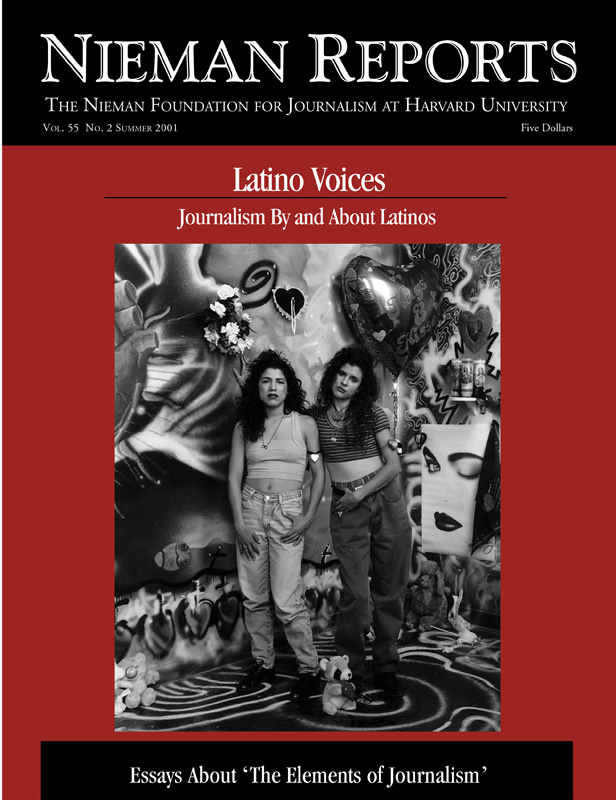
"Júbilo en Miami”—Joy in Miami—read a front-page headline in El Nuevo Herald during the height of the Elián González saga. That day, El Nuevo Herald, the premier Spanish-language paper in Miami, chose to focus on the relief felt by many because the little boy remained in the United States, although his Miami relatives had defied a court order to return him to authorities.
That same day, The Miami Herald, El Nuevo Herald’s sister paper, ran a much more somber, straight-laced headline: “Family Defies Order.”
Which newspaper was right? Each one thought it had it right, and probably did—for its target audience.
For most of its existence, El Nuevo Herald was only a supplement to the Herald, often publishing translations of the stories from the larger English-language broadsheet. Though it informed its community, it seemed to do so as a Herald wannabe. Moreover, those readers who preferred to read in Spanish were often resentful that they were forced to purchase an English-language paper to read the Spanish-language one.
Independence came in 1998 when The Miami Herald publisher Alberto Ibargüen convinced then-publisher David Lawrence, Jr. to separate both papers and brought in Carlos Castañeda, a well-known Cuban-born journalist who had turned around Puerto Rico’s El Nuevo Dia. Almost overnight El Nuevo Herald—the largest Spanish-language daily in this county of 2.2 million people, 57 percent of whom are Hispanic—became a paper with its own style and personality designed to suit its potential readers. The newspaper was transformed into a colorful broadsheet with the soul of a tabloid. Stories were shorter. Pictures were bigger, and although there were no full editorials, short unsigned commentaries appeared on page three.
Top stories about local news, Cuba and Latin America mixed in the front page with stories about the latest Latino pop music star or the hottest soap opera star. El Nuevo Herald editors who were accustomed to diligently reading the news budgets of the Herald before news meetings to select articles for their paper did something quite different: they began discarding these story ideas and replacing them with staff-produced reports or Spanish-language wire stories.
Today, both newspapers make their editorial decisions independently. At first, many bilingual readers who were used to reading both papers (and these kind of readers make up 63 percent of El Nuevo Herald subscribers) were a bit startled when they found a story was played one way in one paper and quite differently in the other. Some readers questioned whether El Nuevo Herald had abandoned American-style journalism for a more partisan one.
Castañeda says he was given the liberty to create a paper that could not be confused with the Herald. And, indeed, he’s done just that. “The paper [El Nuevo Herald] is conceived differently,” Ibargüen said. “It is frankly and unapologetically of the community in all its hemispheric diversity. It has a Latin sense of humor and taste and with a pan-Latin sense that the more Miami-oriented Herald doesn’t have.”
The Elián crisis brought the difference between both papers under the spotlight. During the six-month ordeal each newspaper seemed to be covering a different world. El Nuevo Herald, with its 60 percent Cuban-American readership, took a more aggressively anti-Castro approach in its coverage. In a special section, which appeared at mid-day on the day Elián was taken from his Miami home, the headline read: “¡Que Vergüenza!” (How Shameful!), accompanied by the photograph of the federal agent pointing a gun at the boy and his rescuer, Donato Dalrymple.
This type of opinionated headline was popular among many in the Cuban-American community, and 17,000 copies of that special edition were sold that afternoon. But some observers in the Herald newsroom were appalled at its brazen editorial tone. They also questioned why El Nuevo Herald chose not to run columns by those who wanted the child to be returned to his father.
Castañeda makes no excuses for his paper’s coverage and says that El Nuevo Herald covers the Latin community through its own “eyes and culture.” He cites circulation numbers to document the paper’s success. Since 1998, circulation has climbed to 90,543 daily and 97,705 on Sundays, a six and 14 percent increase, respectively. Ad revenues have also shot up by 17.6 percent.
But in Miami, perhaps the most bilingual city in the United States, the Herald still has the larger number of Hispanic readers. During any given week, 235,000 Hispanics read the Herald. By now, most bilingual readers have accepted El Nuevo Herald’s independence and recognize that each paper is a separate journalistic entity, even though both staffs work under the umbrella of The Miami Herald Publishing Company.
Despite being housed in the same large building at One Herald Plaza, reporters from both newsrooms tend to keep to their turf. The El Nuevo Herald newsroom has a newsroom staff of 90; The Herald has a newsroom almost five times as large. But El Nuevo Herald, with 14 Latin American nationalities represented on its staff, considers itself a competitor to its larger sibling. And reporters there are encouraged to practice “guerilla journalism,” filling the voids their giant sibling might leave behind. Indeed, at times El Nuevo Herald has beaten the Herald in its coverage of Cuba.
One example was the El Nuevo Herald story that ran on March 7 about the Varela project—a call for a referendum on issues of basic human rights signed by 119 dissident groups in Cuba. The Herald did not run any articles on the project but did run a short editorial praising the effort. Susana Barciela, a Cuban-born editorial writer who reads El Nuevo Herald daily, wrote the editorial. She not only gets ideas for editorials from that paper but she often translates and publishes op-ed pieces that run in it.
Mark Seibel, the Herald’s assistant managing editor for news, has seen the changes between the two newsrooms evolve from collaboration to competition, so that Herald news editors ponder whether to put certain stories on their news budgets for fear that the other newsroom might steal the idea.
“I see them [El Nuevo Herald] absolutely as competitors,” Seibel said. He often uses El Nuevo Herald’s extensive sports coverage of soccer as an example of what the Herald should be doing. “But I guess it’s a process,” he added. “We are still bound by what most American-style newspapers do. We read The New York Times’s budgets and The Associated Press. Sometimes the stories we want may not be readily available in English.”
Aminda Marques, Herald deputy metro editor, who supervises reporters during the day, peruses El Nuevo Herald’s news budgets during the morning and relies on El Nuevo Herald’s reporters and photographers to cover “very Hispanic” events that she might not have staff to deploy. But her reporters do cover the Hispanic community at large (again, the majority population in this area), and though no one particular reporter is assigned to any particular Latino population group, stories with Hispanics bubble to the top anyway.
Other cross-pollination goes on between the papers. Herald writer Andrés Oppenheimer, a popular Argentinean-born columnist, writes a weekly column about Latin America that is a staple in both papers. The two papers also tend to rely on each other’s photographers when there is an excessive amount of assignments. And last April, El Nuevo Herald’s reporter Pablo Alfonso covered the United Nation Commission on Human Rights Conference in Geneva. His story on the vote condemning Cuba’s lack of human rights was translated and appeared on each paper’s front page. The difference: The English version also included news about how China and Israel fared before the same commission.
Martin Baron, the Herald’s executive editor, who is bilingual, likes to point out The Miami Herald has a much larger mission than El Nuevo Herald. His paper has to satisfy the needs of non-Hispanic whites, African Americans, a large Jewish population, as well as an increasing bilingual population of Hispanics. “It’s a different world that they cover,” Baron says. “A lot of El Nuevo Herald’s readers are recently arrived and struggle with English. The Herald’s challenge is larger.” Baron would like his copyediting staff to include more bilingual editors so they are able to monitor El Nuevo Herald’s news budgets more closely. And he admits that a front-page El Nuevo Herald story on an influx of Argentineans to Miami Beach is something that “the Herald should have had.”
The Herald’s investigative reporters sometimes fume when their sister paper ignores their reports. For example, the Herald’s report on the presidential ballot reviews, which counted 64,000 undervotes throughout Florida’s 67 counties, was front-page news in the Herald but relegated to a short article on page two of El Nuevo Herald. Editors at that paper cite space and time restraints (their paper goes to the press earlier than the Herald does) as impediments to including certain relevant Herald articles in their pages.
But, as Castañeda explains, the differences lie in how each paper exercises its news judgment. And with different audiences to engage, that judgment is tested—and evaluated by Miami’s readers—each day these two newspapers appear.

Armed federal agents enter the bedroom of Lazaro González in Miami's Little Havana early Saturday morning, April 22, 2000. Photo by Alan Diaz/The Associated Press.
Bárbara Gutiérrez, a 1993 Nieman Fellow, is the reader representative of The Miami Herald/El Nuevo Herald. At the time she was appointed reader representative, she was executive editor of El Nuevo Herald. Born in Cuba, Bárbara came to the United States in 1964 with her parents and younger brother.



